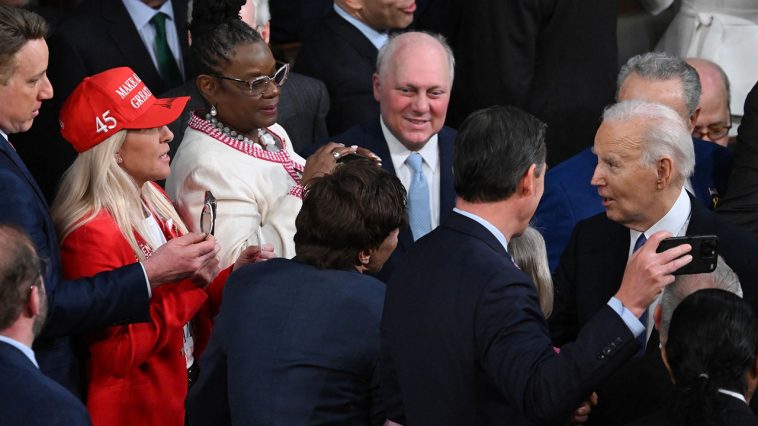In a bold display of allegiance and conviction, Rep. Marjorie Taylor Greene (R-GA) took her stance on the U.S. House floor donned in a vibrant red hat echoing the sentiment ‘Make America Great Again,’ during President Joe Biden’s State of the Union. Greene’s act, undeniably conspicuous, has given rise to debates about its adherence to House regulations. House edicts deem its premises as governmental resources and generally expect members to refrain from activities suggestive of campaigning.
Greene’s adornment could be interpreted as a form of campaign activity considering the resonating impact of the MAGA symbol. However, it is not the first time the representative made her presence felt during Biden’s address to the nation. As a key figure in the House, Greene has a history of making noteworthy appearances during these significant political discourses.
As Biden made his entrance into the House on the eventful night, Greene took the opportunity to voice a subject close to her heart. The representative attempted to initiate a direct dialogue with the President, insisting he ‘say her name.’ The phrase was intended to draw attention to the tragic case of Laken Riley, a young woman who lost her life allegedly at the hands of an undocumented immigrant.
President Biden, however, appeared to steer clear of engaging directly with Greene’s provocation. Actions that could potentially disrupt decorum on this grand platform seemed to be carefully avoided. Concurrently, Representative Gwen Moore (D-WI) made efforts to ensure that Biden was able to maintain his distance from the intense encounter with Greene.
Biden’s face at seeing Marjorie Taylor Greene is killing me pic.twitter.com/65XUOkOyYT
— B.W. Carlin (@BaileyCarlin) March 8, 2024
Despite the initial reluctance, President Biden—during the course of his address—did address the matter of Laken Riley as encouraged by Greene. He acknowledged the tragic end that befell the young nursing student by holding up a button bearing her name and accepting that she fell victim to an ‘illegal,’ a term generally avoided in the Democratic vocabulary for its incendiary connotation.
Greene’s unique act of protest, while resulting in her aim of acknowledgment, could potentially draw backlash. Her choice of attire on the House floor—a distinctive campaigning symbol—didn’t go unnoticed. Rep. Jamie Raskin (D-MD) called out Greene’s action as being ‘in direct violation of the rules of the House’ in a tweet later that evening.
Raskin, highlighting Greene’s conduct, drew attention to the fact that she was wearing campaign-themed attire—an act considered non-compliant with the ethos of the House—in the official setting. His admonition could potentially lead to the element of an ethics inquiry into this spirited resistance displayed by Greene.
However, the possibility of substantial censure arising against the representative remains debatable. In a House that has a considerable influence of Republicans, the likelihood of an ethics complaint resulting in a tangible reprimand may not be quite feasible.
Greene, on the other hand, didn’t let Raskin’s critique pass without retort. She responded to the postulation of her alleged violation by maintaining that it was indeed President Biden who was overlooking his duties. Greene’s counter was directed at what she claimed to be Biden’s ‘direct violation’ of his responsibilities concerning the U.S.-Mexico border.
The entire episode involving the gauntlet of Greene’s sartorial choice, her confrontation with Biden, and the subsequent Twitter altercation with Raskin offers a darkly intricate tableau. It captures the stark political divide, the ideological discrepancies, and the ongoing battle for supremacy that continue to dominate American politics.
Greene’s bold defiance may stimulate debates on the limits of freedom of expression within the House traditions. More critical is the larger question about dealing with the real and perceived threats to the American socio-economic landscape. Her act raises the question: Should House decorum come at the expense of suppressing extensive discussions on national security concerns?
However, naysayers might argue that discourse in the House around sensitive issues should aim for constructive problem-solving rather than creating a public spectacle. They might insist that the representation of constituents’ interests should be carried out through formalized channels and negotiations with relevant stakeholders.
Greene’s indirect invocation of the border security issue during a crucial occasion like the State of the Union seeks to underline its importance. However, to some, her approach might signal an unrestrained exhibitionism rather than a well-thought-out strategy to bring about change.
While debates about the appropriateness of her actions persist, Greene’s bold demonstration brings into focus the key underlying issue of protecting America’s sovereign borders and the lives within. It puts the subject on the national stage like never before, warranting thoughtful discourse and requisite action.
As lawmakers grapple with the legislative nuances and the political chessboard, the citizens look to them for assurance. Protection, provision, and progress—that’s what the populace desires. Leaders like Greene, through their words and actions, keep provoking the administration to ensure that these issues, critical to the American way of life, remain center-stage in the narrative.


